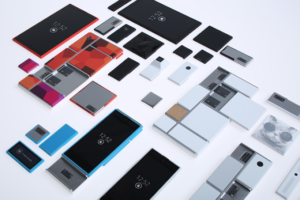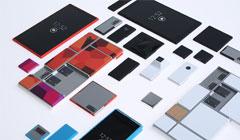 It's not just about the latest superphones with their multicore processors, miniaturized architecture and ever expanding warehouses of applications. Motorola just announced that it's been working on Project Ara, a free and open platform for creating highly modular smartphones. Phonebloks, another modular phone visionary, is teaming up with Motorola to push the sector to critical mass. On its blog, Motorola says its goal is to “drive a more thoughtful, expressive, and open relationship between users, developers, and their phones. To give you the power to decide what your phone does, how it looks, where and what it’s made of, how much it costs, and how long you’ll keep it.” Will it pan out? And how will it affect mobile development? Who's to say? Motorola has produced solid hardware for decades, but there’s no doubt it’s struggled in the smartphone market compared to Samsung and Apple. This might be its last-ditch effort to stay in the game. It could also be gazing into its crystal ball and creating a whole new hardware ecosystem. Look outside the mobile market and hardware disruption is running rampant. Developers, programmers and engineers are quickly taking advantage of the latest tools, techniques and readily available production capacities to create radical (or not so) hardware/software/networked products and services. The Nest is a great example of a handful of go-getters looking at a mundane, everyday device (the thermostat) and making it better -- while building a new company around the whole effort. Jump on Amazon or walk through any Lowes home improvement store and you'll see that the Nest is a real, live, functioning product that you can actually buy.
It's not just about the latest superphones with their multicore processors, miniaturized architecture and ever expanding warehouses of applications. Motorola just announced that it's been working on Project Ara, a free and open platform for creating highly modular smartphones. Phonebloks, another modular phone visionary, is teaming up with Motorola to push the sector to critical mass. On its blog, Motorola says its goal is to “drive a more thoughtful, expressive, and open relationship between users, developers, and their phones. To give you the power to decide what your phone does, how it looks, where and what it’s made of, how much it costs, and how long you’ll keep it.” Will it pan out? And how will it affect mobile development? Who's to say? Motorola has produced solid hardware for decades, but there’s no doubt it’s struggled in the smartphone market compared to Samsung and Apple. This might be its last-ditch effort to stay in the game. It could also be gazing into its crystal ball and creating a whole new hardware ecosystem. Look outside the mobile market and hardware disruption is running rampant. Developers, programmers and engineers are quickly taking advantage of the latest tools, techniques and readily available production capacities to create radical (or not so) hardware/software/networked products and services. The Nest is a great example of a handful of go-getters looking at a mundane, everyday device (the thermostat) and making it better -- while building a new company around the whole effort. Jump on Amazon or walk through any Lowes home improvement store and you'll see that the Nest is a real, live, functioning product that you can actually buy.
Get Ready for Disruption in Mobile Hardware
In spite of the ongoing battles in Washington over the economy, NSA spying, and international policy, I'm absolutely certain that there's never been a better time to be in tech, particularly in anything mobile. I think we'll see a bunch of new jobs evolving as we transition into the coming age of hardware disruption.  It's not just about the latest superphones with their multicore processors, miniaturized architecture and ever expanding warehouses of applications. Motorola just announced that it's been working on Project Ara, a free and open platform for creating highly modular smartphones. Phonebloks, another modular phone visionary, is teaming up with Motorola to push the sector to critical mass. On its blog, Motorola says its goal is to “drive a more thoughtful, expressive, and open relationship between users, developers, and their phones. To give you the power to decide what your phone does, how it looks, where and what it’s made of, how much it costs, and how long you’ll keep it.” Will it pan out? And how will it affect mobile development? Who's to say? Motorola has produced solid hardware for decades, but there’s no doubt it’s struggled in the smartphone market compared to Samsung and Apple. This might be its last-ditch effort to stay in the game. It could also be gazing into its crystal ball and creating a whole new hardware ecosystem. Look outside the mobile market and hardware disruption is running rampant. Developers, programmers and engineers are quickly taking advantage of the latest tools, techniques and readily available production capacities to create radical (or not so) hardware/software/networked products and services. The Nest is a great example of a handful of go-getters looking at a mundane, everyday device (the thermostat) and making it better -- while building a new company around the whole effort. Jump on Amazon or walk through any Lowes home improvement store and you'll see that the Nest is a real, live, functioning product that you can actually buy.
It's not just about the latest superphones with their multicore processors, miniaturized architecture and ever expanding warehouses of applications. Motorola just announced that it's been working on Project Ara, a free and open platform for creating highly modular smartphones. Phonebloks, another modular phone visionary, is teaming up with Motorola to push the sector to critical mass. On its blog, Motorola says its goal is to “drive a more thoughtful, expressive, and open relationship between users, developers, and their phones. To give you the power to decide what your phone does, how it looks, where and what it’s made of, how much it costs, and how long you’ll keep it.” Will it pan out? And how will it affect mobile development? Who's to say? Motorola has produced solid hardware for decades, but there’s no doubt it’s struggled in the smartphone market compared to Samsung and Apple. This might be its last-ditch effort to stay in the game. It could also be gazing into its crystal ball and creating a whole new hardware ecosystem. Look outside the mobile market and hardware disruption is running rampant. Developers, programmers and engineers are quickly taking advantage of the latest tools, techniques and readily available production capacities to create radical (or not so) hardware/software/networked products and services. The Nest is a great example of a handful of go-getters looking at a mundane, everyday device (the thermostat) and making it better -- while building a new company around the whole effort. Jump on Amazon or walk through any Lowes home improvement store and you'll see that the Nest is a real, live, functioning product that you can actually buy.
 It's not just about the latest superphones with their multicore processors, miniaturized architecture and ever expanding warehouses of applications. Motorola just announced that it's been working on Project Ara, a free and open platform for creating highly modular smartphones. Phonebloks, another modular phone visionary, is teaming up with Motorola to push the sector to critical mass. On its blog, Motorola says its goal is to “drive a more thoughtful, expressive, and open relationship between users, developers, and their phones. To give you the power to decide what your phone does, how it looks, where and what it’s made of, how much it costs, and how long you’ll keep it.” Will it pan out? And how will it affect mobile development? Who's to say? Motorola has produced solid hardware for decades, but there’s no doubt it’s struggled in the smartphone market compared to Samsung and Apple. This might be its last-ditch effort to stay in the game. It could also be gazing into its crystal ball and creating a whole new hardware ecosystem. Look outside the mobile market and hardware disruption is running rampant. Developers, programmers and engineers are quickly taking advantage of the latest tools, techniques and readily available production capacities to create radical (or not so) hardware/software/networked products and services. The Nest is a great example of a handful of go-getters looking at a mundane, everyday device (the thermostat) and making it better -- while building a new company around the whole effort. Jump on Amazon or walk through any Lowes home improvement store and you'll see that the Nest is a real, live, functioning product that you can actually buy.
It's not just about the latest superphones with their multicore processors, miniaturized architecture and ever expanding warehouses of applications. Motorola just announced that it's been working on Project Ara, a free and open platform for creating highly modular smartphones. Phonebloks, another modular phone visionary, is teaming up with Motorola to push the sector to critical mass. On its blog, Motorola says its goal is to “drive a more thoughtful, expressive, and open relationship between users, developers, and their phones. To give you the power to decide what your phone does, how it looks, where and what it’s made of, how much it costs, and how long you’ll keep it.” Will it pan out? And how will it affect mobile development? Who's to say? Motorola has produced solid hardware for decades, but there’s no doubt it’s struggled in the smartphone market compared to Samsung and Apple. This might be its last-ditch effort to stay in the game. It could also be gazing into its crystal ball and creating a whole new hardware ecosystem. Look outside the mobile market and hardware disruption is running rampant. Developers, programmers and engineers are quickly taking advantage of the latest tools, techniques and readily available production capacities to create radical (or not so) hardware/software/networked products and services. The Nest is a great example of a handful of go-getters looking at a mundane, everyday device (the thermostat) and making it better -- while building a new company around the whole effort. Jump on Amazon or walk through any Lowes home improvement store and you'll see that the Nest is a real, live, functioning product that you can actually buy.

